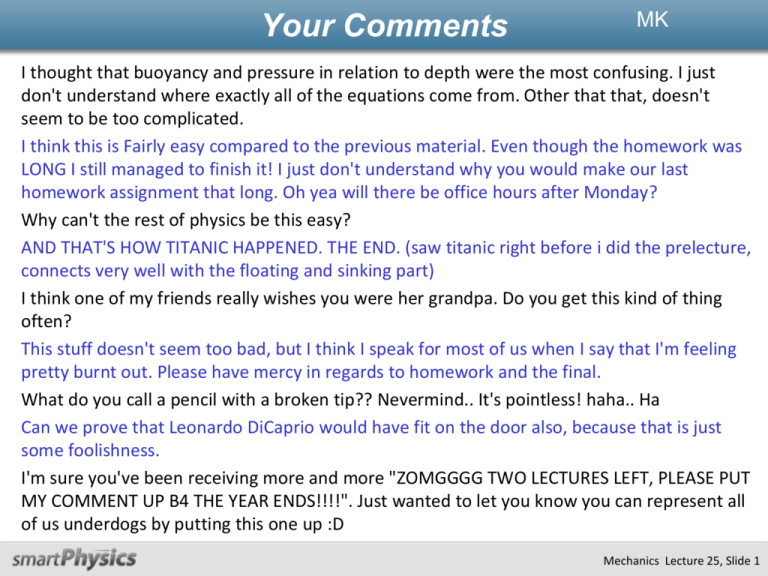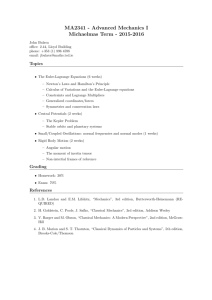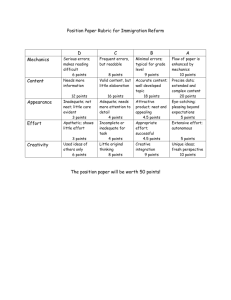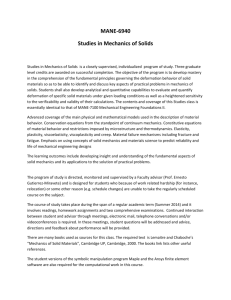Physics 211
advertisement

Your Comments MK I thought that buoyancy and pressure in relation to depth were the most confusing. I just don't understand where exactly all of the equations come from. Other that that, doesn't seem to be too complicated. I think this is Fairly easy compared to the previous material. Even though the homework was LONG I still managed to finish it! I just don't understand why you would make our last homework assignment that long. Oh yea will there be office hours after Monday? Why can't the rest of physics be this easy? AND THAT'S HOW TITANIC HAPPENED. THE END. (saw titanic right before i did the prelecture, connects very well with the floating and sinking part) I think one of my friends really wishes you were her grandpa. Do you get this kind of thing often? This stuff doesn't seem too bad, but I think I speak for most of us when I say that I'm feeling pretty burnt out. Please have mercy in regards to homework and the final. What do you call a pencil with a broken tip?? Nevermind.. It's pointless! haha.. Ha Can we prove that Leonardo DiCaprio would have fit on the door also, because that is just some foolishness. I'm sure you've been receiving more and more "ZOMGGGG TWO LECTURES LEFT, PLEASE PUT MY COMMENT UP B4 THE YEAR ENDS!!!!". Just wanted to let you know you can represent all of us underdogs by putting this one up :D Mechanics Lecture 25, Slide 1 Make sure you don’t have a double confict Combined final: Wednesday May 9 at 1:30 pm. Conflict final: Thursday May 10 at 8 am. “If what really matters in college is what you learn throughout the semester and not your grade, does that mean an A on the final will get you an A in this course?” If you want to know how to calculate your grade look at the first lecture Mechanics Lecture 17, Slide 2 Physics 211 Lecture 25 Today’s Concepts: A) Static Fluids B) Archimedes Principle Mechanics Lecture 25, Slide 3 Pressure due to an Liquid or Gas Forces are caused by the movement and collisions of molecules. Mechanics Lecture 25, Slide 4 Pressure due to a Liquid or Gas Pressure is the force per unit area due to these collisions. “These concepts are understandable and not difficult. I was wondering, however, if the shape of a glass is related to this principle? I noticed that the shape of the glass tapers as it goes down. Is this to reduce the force of the liquid on the glass?” Mechanics Lecture 25, Slide 5 Recall where this comes from A Doesn't depend on shape Mechanics Lecture 25, Slide 6 Pressure changes with depth Think of it like this: The pressure at some depth is due to the weight of everything above that depth. “I dont understand how water has more weight as you go lower” Mechanics Lecture 25, Slide 7 CheckPoint A yacht floats in a large pool. Compare the water pressure directly below the hull of the yacht (point A) to the pressure at the same depth beside the ship (point B). The weight of the ship is the same as the weight of the displaced water A B A) PA > PB B) PA = PB C) PA < PB Points at the same depth have the same pressure Mechanics Lecture 25, Slide 8 Clicker Question Two dams of equal height and width prevent water from entering a central basin. Compare the net force due to the water on the two dams. A) FA > FB B) FA= FB C) FA< FB “As a scuba diver, I find a lot of this rather interesting. As a student I kind of just want to be studying for finals.” Mechanics Lecture 25, Slide 9 Atmospheric Pressure The weight of atmosphere. Air molecules are colliding with you right now! Patm = 1x105 N/m2 = 14.7 lbs/in2 Example: Sphere with r = 0.1 m A = 4pr2 = .125 m2 F = 12,000 Newtons (over 2,500 lbs)! Hemisphere Demo Crush can Glass Mechanics Lecture 25, Slide 10 Does Air Really Weigh That Much? 8 km high stack weighs 105 N Patm at 16 km its only 10% of Patm at sea level 1 mole N2 = 28 g 1 mole = 22.4 liters at STP 1m 1m 1 m3 N2 at STP M = 1.25 kg Weight = 12 N Mechanics Lecture 25, Slide 11 Measuring Patm Hwater ~ 10 m (33 ft) for normal Patm Hmercury ~ 30” for normal Patm Mechanics Lecture 25, Slide 12 Clicker Question Can you drink water through a long straw from a platform 40 feet above a glass of water. A) Yes – you just have to suck hard enough. B) No – it cant work no matter how hard you suck. 40 feet Buoyancy A floating object displaces its own weight Mechanics Lecture 25, Slide 14 Excellent Question Alright, call me naive, but why does the buoyant force always point up? I understand it perfectly whenever the object is floating or suspended in the liquid, but not when the object is at the bottom of the container. Since the buoyant force is caused by the collisions of the molecules of liquid on the object, wouldn't the buoyant force at the bottom not face upward since there's no liquid molecules to collide in the upward direction? Would the buoyant force then just be the normal force given off by the container? CheckPoint Suppose you float an ice-cube in a glass of water, and that after you place the ice in the glass the level of the water is at the very brim. When the ice melts, the level of the water in the glass will: A) Go up, causing the water to spill out of the glass. B) Go down. C) Stay right at the brim. “Bring some icecubes and lets have some drinks :)” Mechanics Lecture 25, Slide 16 CheckPoint When the ice melts, the level of the water in the glass will: A) Go up, causing the water to spill out of the glass. B) Go down. C) Stay right at the brim. A) The water level will rise. I learned that from Al Gore in "An Inconvenient Truth" B) volume of ice is greater than volume of water C) The melted water has exactly the same mass as the ice cube, and the volume of water displaced is equal to the mass of the ice cube. “The ice melting in cup of water question confuses me. So if the water level doesn't change, why worry about global warming?” Mechanics Lecture 25, Slide 17 Clicker Question Which weighs more: A) A large tub filled to the brim with water. B) A large tub filled to the brim with water with a battle-ship floating in it. C) They will weigh the same. Tub of water + ship Tub of water Overflowed water weighs the same as the ship Weight of ship = Buoyant force = Weight of displaced water Mechanics Lecture 25, Slide 18 CheckPoint When you float an ice cube in water you notice that 90% of it is submerged beneath the surface. Now suppose you put the same ice cube in a glass of some liquid whose density is less than that of water. How much of the ice cube will be submerged? A) More than 90% B) 90% C) Less than 90% A) It must displace more of the liquid to equal its weight B) lower density meant that the ice cube will be heavier C) If the density of the the liquid is less than the density of water than there will be less buoyant force on the ice cube and it will sink farther. Mechanics Lecture 25, Slide 19 PATM PI PB Mechanics Lecture 25, Slide 20 PATM PB PB PATM = w gh1 PB = PATM w gh1 Mechanics Lecture 25, Slide 21 PI PB PB PI = w gh2 PI = PB w gh2 Mechanics Lecture 25, Slide 22 PATM PI PI PATM = oil gh3 oil PI PATM = gh3 Mechanics Lecture 25, Slide 23 PATM PI PI PATM = glycerin gh3 PI = PATM glycerin gh3 Mechanics Lecture 25, Slide 24 PATM h1 PI h2 PB = PATM w gh1 PB = PI w gh2 PB PI PATM h1 h2 = w g h1 h2 = 0.5 (same as before) So we know h1, h2, h3 = 0.391 Solve for h1, h2 d = h1 h2 h3 Mechanics Lecture 25, Slide 25 PI h2 PB = PI w gh2 PB We know both PI and h2 (prev. slides) Mechanics Lecture 25, Slide 26






